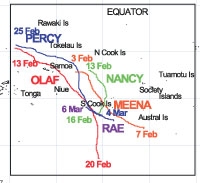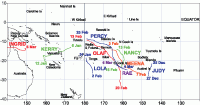Tropical Cyclones in the Cook Islands
Arona Ngari, Director, Cook Islands Meteorological Service
Background



During the 2004/05 tropical cyclone season, February was the most memorable among Cook Islanders living at home and abroad. It was the month that five cyclones (Meena, Nancy, Olaf, Percy, and Rae – See Figure 1) occurred within a period of five weeks. Four of these cyclones reached sustained wind speeds of over 100 knots (185 km/h), and gusts of 140 knots (259 km/h), a record frequency of occurrence for the Cook Islands. One cyclone also recorded the lowest barometric pressure ever measured for a cyclone in the South Pacific – 900 hPa.
Percy and Olaf formed northwest of Samoa, where the sea surface temperature was at least 28 °C in February, and more than 30 °C during the previous few months. Meena and Nancy formed between Samoa and the Northern Cook Islands before moving in to the Southern Cook Islands area. Rae formed southeast of Niue.
Damage from the Tropical Cyclones
What stood out about these cyclones was the havoc they created on some of the islands that they passed over or close by. For example, when Meena was closest to Rarotonga, it brought storm surges and high winds to the northern part of the island, blowing rubble into buildings along the uptown area in Avarua. The roof of a restaurant was breached by huge waves, which also demolished premises along the coastal area. The estimated height of these waves was about 14 m. The highest estimated sustained winds within the cyclone were 125 knots (232 km/h), with estimated gusts of 155 knots (287 km/h). Recorded winds were 46 knots (85 km/h) with gusts of 64 knots (119 km/h). The lowest central pressure recorded in Aitutaki was 985.9 hPa.
The arrival of Nancy brought storm surges to the eastern parts of Rarotonga, where several buildings were inundated with seawater, and even some of the hurricane safety centres were threatened by the storm surge. Mean wind speeds reached 53 knots (98 km/h), with gusts to 88 knots (163 km/h) at Rarotonga. The lowest pressure recorded there was 987.5 hPa at Rarotonga.
Olaf almost merged with Nancy, forcing it to track closer to Rarotonga. This cyclone wreaked havoc in the northwestern part of the island, rubble and trees were strewn on buildings, and windows broken in some hotels on this side of the island. The highest recorded winds at Rarotonga Airport were 38 knots (70 km/h), with gusts to 51 knots (95 km/h).
Percy devastated the islands of Pukapuka and Nassau in the Northern Cook Islands, but by the time it reached the Southern Cook Islands nine days later, it had weakened. Cyclone Percy recorded the lowest barometric pressure ever in a South Pacific cyclone (estimated at 900 hPa or 898 hPa recorded by NOAA). The highest sustained winds recorded at Pukapuka were 90 knots (167 km/h), with gusts up to 120 knots (222 km/h). A state of emergency was declared for Pukapuka and Nassau.
Rae lasted for only about 10 hours as a cyclone. Rae brought much needed rain to wash away the sea-spray that had been brought by the former cyclones, which gave the islands some more greenery that was lost during the earlier cyclones. The maximum winds recorded were 30 knots (56 km/h), with gusts of 40 knots (74 km/h).
Although the small islands of the Cook Islands were hit by five tropical cyclones this cyclone season, there were no casualties. Pukapuka and Nassau were the worst affected islands in the group as they were hit by two cyclones, and a state of emergency was declared twice. Most of the other islands in the group reported minor damage.
